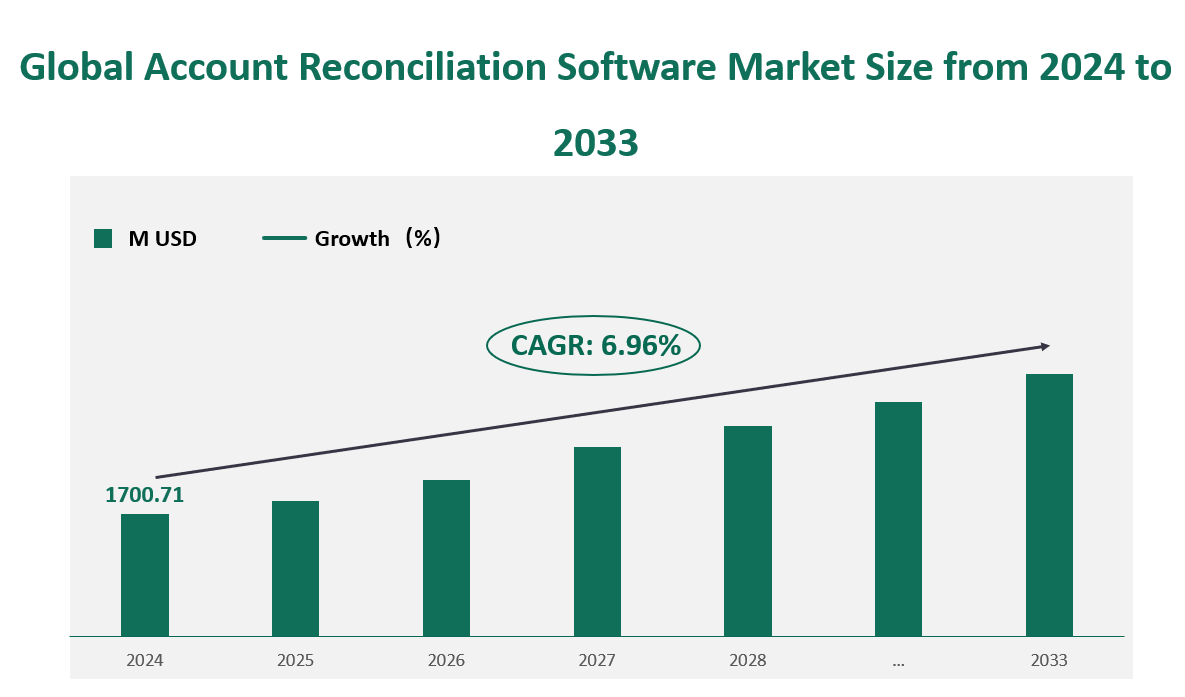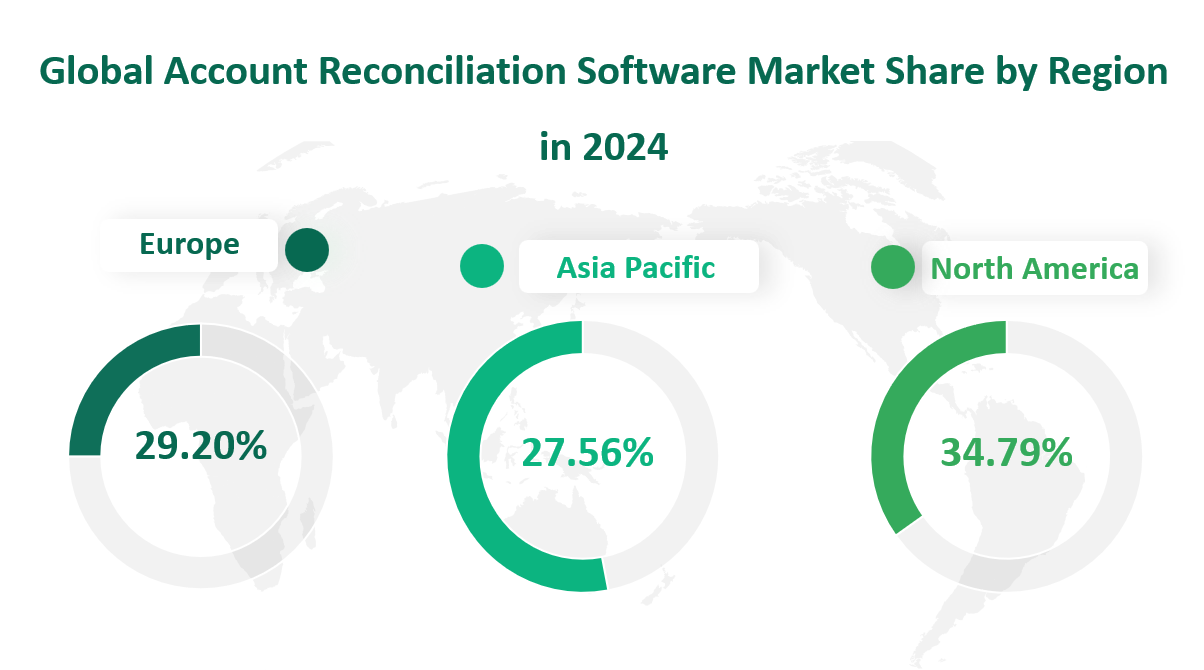1 Global Account Reconciliation Software Market Size (Revenue) and CAGR (2024-2033)
Global Account Reconciliation Software market generated revenue of USD 1700.71 Million in 2024 with a CAGR of 6.96% during 2024 to 2033.
Looking ahead to 2033, the Account Reconciliation Software market is poised for continued growth. The increasing adoption of cloud-based solutions, driven by their cost-effectiveness and scalability, is expected to drive market expansion. Additionally, the growing emphasis on data security and regulatory compliance will further fuel demand for advanced reconciliation software. Companies are increasingly investing in artificial intelligence and machine learning technologies to enhance the accuracy and efficiency of reconciliation processes. These advancements will not only improve financial management but also contribute to the overall growth of the market.
Figure Global Account Reconciliation Software Market Size (M USD) Outlook (2024-2033)

2 Account Reconciliation Software Industry SWOT Analysis
Table SWOT Analysis
Item | Description |
Strength | Standardized reconciliation processes can improve the quality and accuracy of financial data and reduce errors and inaccuracies. This saves a lot of time and allows highly skilled accountants to focus on more difficult tasks, such as analysis, risk mitigation, and exception handling. Data integration and built-in integrity checks simplify process management. The use of technology to simplify account reconciliation helps ensure accurate and effective accounting activities. |
Weakness | Usually, the fee is charged by the bank or other intermediary to the transaction along the way, and it is automatically added to the transaction amount. However, the amount on the bank statement cannot be matched with the amount in internal records, which hinders the matching process. Time constraints can be a problem for users. The success of the software depends on the quality of the input data. Accurate data and timely reconciliation ensure good reports for review. If users do not have enough time to enter data and check their accounts, it will affect their experience. |
Opportunity | The growth of the global economy and the various initiatives put forward by governments of various countries and regions to achieve their policy goals are expected to promote the growth of the global account reconciliation software market in the next few years. The adoption rate of SME reconciliation software is higher, and the use rate of machine learning and artificial intelligence in reconciliation software is rising. These factors are expected to provide rich opportunities for market growth. |
Threat | When a company opens an account in one currency but receives payment in another currency, it immediately leads to a mismatch between the bank documents and the internal system. How to link those completely different numbers is a big challenge. The growing IT department has not only brought many advances, but also brought a lot of challenges in terms of security related to data storage between users. Due to the lack of skilled professionals, the growth of the global account reconciliation software market may also be hindered. |
3 Global Account Reconciliation Software Market by Type in 2024
The global Account Reconciliation Software market is segmented into two primary product types: Cloud-based and On-Premise solutions.
Cloud-based Solutions
Cloud-based Account Reconciliation Software refers to solutions that are hosted on remote servers and accessed via the internet. These solutions offer several advantages, including real-time access, scalability, and reduced maintenance costs. They are particularly favored by enterprises looking to streamline their operations and reduce the burden of on-site IT infrastructure. In 2024, the Cloud-based segment accounted for 42.55% of the total market share, generating a revenue of $723.72 million USD. This segment is characterized by its dynamic features, such as risk-based reconciliation automation, custom attributes, real-time dashboard reporting, and automatic transaction matching. These capabilities make Cloud-based solutions highly attractive for enterprises seeking to enhance operational efficiency and compliance.
On-Premise Solutions
On-Premise Account Reconciliation Software, on the other hand, refers to solutions that are installed and operated on the user’s own servers and infrastructure. This type of software is preferred by enterprises that prioritize data security and control over their IT systems. In 2024, the On-Premise segment held a larger market share of 57.45%, with a revenue of $977.00 million USD. On-Premise solutions are known for their ability to provide real-time visibility into reconciliation processes, simplify performance optimization, and support risk-based reconciliation cycles. These features are particularly valuable for enterprises with stringent data security requirements and complex IT environments.
Table Global Account Reconciliation Software Market Size and Share by Type in 2024
Type | Revenue (M USD) | Market Share (%) |
|---|---|---|
Cloud-based | 723.72 | 42.55 |
On-Premise | 977.00 | 57.45 |
Total | 1,700.71 | 100.00 |
4 Global Account Reconciliation Software Market by Application in 2024
The Account Reconciliation Software market serves a variety of applications, primarily focusing on Banks and Enterprises.
Banks
Banks represent a significant portion of the Account Reconciliation Software market, utilizing these solutions to manage their vast financial transactions and ensure regulatory compliance. In 2024, the Bank application segment accounted for 54.11% of the total market share, generating a revenue of $920.33 million USD. Banks rely on reconciliation software to centralize their financial settlement processes, automate transaction matching, and provide secure audit trails. These solutions help banks reduce manual errors, enhance operational efficiency, and meet stringent regulatory requirements. The growth of the Bank segment is driven by the increasing complexity of financial transactions and the need for robust reconciliation processes to ensure financial accuracy.
Enterprises
Enterprises across various industries also benefit from Account Reconciliation Software, using it to verify their financial accounts and ensure the accuracy of their financial data. In 2024, the Enterprise application segment accounted for 45.89% of the total market share, with a revenue of $780.38 million USD. Enterprises utilize reconciliation software to manage their balance sheets, perform transaction matching, and ensure compliance with internal and external financial regulations. The growth of the Enterprise segment is driven by the increasing adoption of digital solutions and the need for efficient financial management in a rapidly evolving business environment.
Table Global Account Reconciliation Software Market Size and Share by Application in 2024
Application | Revenue (M USD) | Market Share (%) |
|---|---|---|
Banks | 920.33 | 54.11 |
Enterprise | 780.38 | 45.89 |
Total | 1,700.71 | 100.00 |
5 Global Account Reconciliation Software Market by Region in 2024
In 2024, the global Account Reconciliation Software market exhibited significant growth across various regions, driven by increasing demand for efficient financial management solutions and the adoption of advanced technologies. The market was segmented into five major regions: North America, Europe, Asia-Pacific, Middle East & Africa, and South America.
North America emerged as the largest regional market in 2024, with a revenue of $591.61 million USD, accounting for 34.79% of the global market share. The region’s dominance can be attributed to its robust economic infrastructure, high adoption of cloud-based solutions, and a strong focus on regulatory compliance. North America’s market growth was further bolstered by the presence of several key players, including Oracle, Fiserv, and BlackLine, which have established strong footholds in the region. The United States, in particular, played a pivotal role in driving the market, with its large financial institutions and enterprises seeking advanced reconciliation solutions to manage complex financial operations.
Europe followed closely, contributing $496.38 million USD in revenue and holding a market share of 29.20%. European countries, such as Germany, the UK, and France, demonstrated strong demand for reconciliation software, driven by stringent regulatory requirements and the need for enhanced financial transparency. The region’s market growth was supported by the increasing adoption of digital solutions and the ongoing efforts to streamline financial processes across various industries. European enterprises, particularly in the banking sector, have been at the forefront of adopting advanced reconciliation tools to ensure compliance with international standards.
Asia-Pacific was the fastest-growing region, with a revenue of $468.61 million USD and a market share of 27.56%. The region’s growth was fueled by rapid economic development, increasing digital transformation, and the rising demand for scalable financial management solutions. Countries like China, Japan, and South Korea led the charge, with their enterprises and financial institutions seeking to enhance operational efficiency and financial accuracy. The Asia-Pacific market benefited from the increasing adoption of cloud-based solutions and the growing emphasis on data security and compliance.
Middle East & Africa and South America also contributed to the global market, with revenues of $84.52 million USD and $69.63 million USD, respectively. These regions, while smaller in market size, demonstrated significant potential for growth, driven by increasing economic activity and the need for advanced financial management tools. The Middle East, in particular, saw growing interest from financial institutions in adopting reconciliation software to manage complex transactions and ensure regulatory compliance.
Table Global Account Reconciliation Software Market Size, Region Wise in 2024
Region | Revenue (M USD) | Market Share (%) |
|---|---|---|
North America | 591.61 | 34.79 |
Europe | 496.38 | 29.20 |
Asia-Pacific | 468.61 | 27.56 |
Middle East & Africa | 69.63 | 4.72 |
South America | 84.52 | 3.76 |
Total | 1,700.71 | 100.00 |
Figure Global Account Reconciliation Software Market Share, Region Wise in 2024

6 Global Account Reconciliation Software Market Top 3 Players
Company Introduction and Business Overview: Oracle Corporation is a multinational computer technology company known for its database software, cloud-engineered systems, and enterprise software products. Established in 1977, Oracle has a global presence, with operations in North America, Europe, Asia-Pacific, and the Middle East & Africa. The company is renowned for its robust database management systems and cloud-based solutions, which cater to the needs of various industries.
Products Offered: Oracle’s flagship product in the reconciliation software market is the Oracle Cloud EPM Account Reconciliation. This solution offers dynamic risk-based reconciliation automation, custom attributes, real-time dashboard reporting, and automatic transaction matching. It is designed to streamline high-volume, labor-intensive reconciliations, ensuring compliance and reducing manual errors.
Revenue in 2020: Oracle’s revenue from Account Reconciliation Software was $152.43 million USD, reflecting its strong market position and ongoing innovation in the field.
Company Introduction and Business Overview: Fiserv is a leading financial data service company that provides solutions to major banks, credit unions, and financial institutions. Established in 1984, Fiserv operates across North America, Europe, Asia-Pacific, and the Middle East & Africa. The company is known for its comprehensive financial services and technology-driven solutions, which help clients manage complex financial operations efficiently.
Products Offered: Fiserv’s Frontier Reconciliation is a comprehensive end-to-end reconciliation and certification solution. It offers real-time visibility into reconciliation processes, automated workflows, and compliance management. Frontier Reconciliation is designed to reduce manual interventions and ensure that all reconciliations meet corporate and regulatory standards.
Revenue in 2020: Fiserv’s revenue from Account Reconciliation Software was $117.54 million USD, highlighting its strong presence in the market and the growing demand for its advanced reconciliation solutions
Company Introduction and Business Overview: BlackLine is a cloud-based software company that specializes in transforming and modernizing accounting and finance operations for organizations of all sizes. Established in 2001, BlackLine offers a range of solutions designed to streamline financial processes, enhance accuracy, and ensure compliance. The company’s products are widely used by enterprises and financial institutions to manage complex financial operations efficiently.
Products Offered: BlackLine’s Account Reconciliation solution provides an intuitive interface for performing reconciliations, with standardized templates, automated workflows, and integrated storage of supporting documentation. The solution is designed to simplify financial close processes, reduce manual errors, and enhance overall financial management.
Revenue in 2020: BlackLine’s revenue from Account Reconciliation Software was $65.18 million USD, reflecting its growing market share and the increasing adoption of its cloud-based solutions.
Table Global Account Reconciliation Software Revenue of Top3 Players in 2020
Company | Revenue (M USD) |
Oracle | 152.43 |
Fiserv | 117.54 |
BlackLine | 65.18 |

